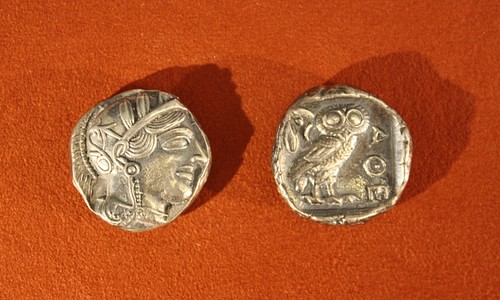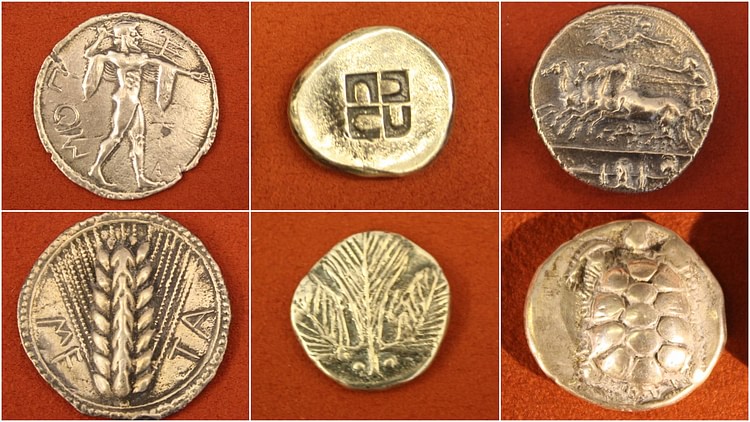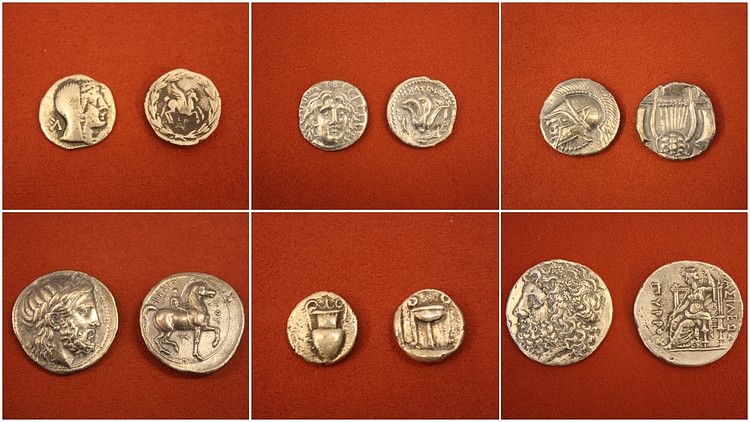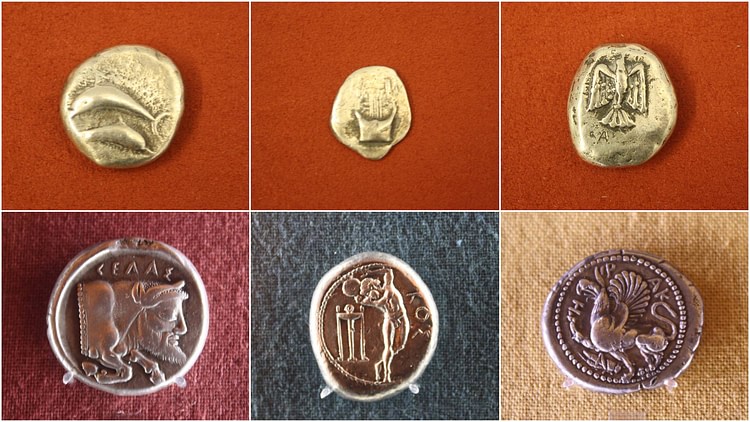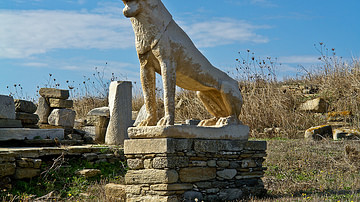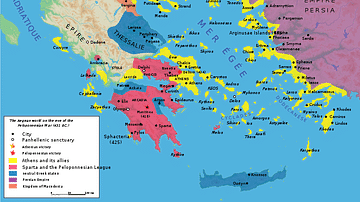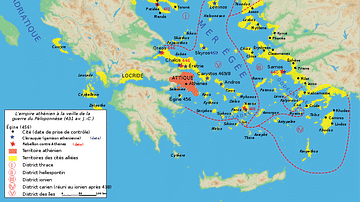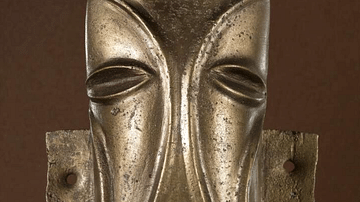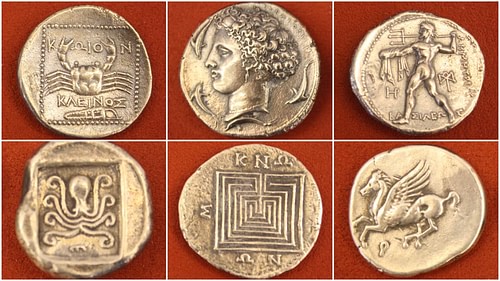
The coinage of ancient Greece has given us some of the most recognisable images from antiquity as they were stamped with designs to proudly declare the identity of the city which minted them and guarantee their value. One of the great archaeological survivors, coins are an invaluable source of information on cultural practices, important individuals, and ancient international relations.
Evolution & Function of Coinage
Trade in the ancient world was largely conducted through the exchange of one type of goods for another in a barter system that worked well for millennia. Eventually, some goods came to be exchanged for large metal bars, such as the bronze or copper talent, which both parties agreed to a value on. The next step was to use metal rods or spits (an obelos from which the obol coin derives its name) which were 1.5 meters in length and six of which could be grasped in the hand. The Greek word for grasp is drattomai and this is the origin of the drachma coin. From these bars and rods sprang the idea for a more portable and universal material which could be exchanged for any goods or service: coinage.
Lydia was credited by the Greeks with inventing coins in the early 6th century BCE which were stamped by the state to guarantee value and be recognisable as genuine. Coins were usually slightly lighter than the same value weight in the pure metal so that the cost of minting them was covered or even a small profit attained. In later centuries some states would abuse this margin and produce coins with lower and lower precious metal content in an attempt to create value where there really was none. After public ridicule, Athens was famously forced to withdraw a batch of plated coinage that had been minted following a financial crisis c. 406 BCE. Then, as now, coinage could only function if people had trust in its present and future value.
The first Greek coins appeared in Aegina c. 600 BCE (or even earlier) which were silver and used a turtle as a symbol of the city's prosperity based on maritime trade. Athens and Corinth soon followed Aegina's lead. The birth of coinage in wider Greece, though, was not really an invention of convenience but a necessity, driven by the need to pay mercenary soldiers. These warriors required a convenient way to carry their wages and the state needed a method of payment they could equally apply to everyone. For maritime trade especially, barter continued to be the most common form of exchange as the problem with coinage in the ancient world was that the value of coins between city-states was often different. Still, for the citizens of a particular city and its surrounding territories coinage became a very useful way to buy and sell goods, and it was convenient for the state to use coins to pay for small public services such as participating in law courts. So convenient was this new portable wealth that poorer Greeks would carry their coins in their mouths when they went to market, and richer Greeks now had a handy means of storing (and hiding) their wealth.
Some larger states were able to impose their currency on other city-states and have it accepted as a means of exchange. The Athenian silver coinage of the 5th century BCE is an example, and perhaps it was the first case of a single currency being used by different states, the members of the Delian League. Examples of the Athenian silver owl tetradrachms have been found as far afield as Egypt, Palestine, Arabia, and Bactria. The Arcadian League was another organisation with a common coinage. Similarly, Alexander the Great would use his coins across the Macedonian empire with many states still minting them two centuries after his death. Other contemporary states would copy the Greek approach to coins and produce their own similar types, such as the Etruscans and Carthaginians.
Minting Coins
Greek coins were made using mostly silver but also gold, electrum (a naturally occurring alloy of silver and gold), copper alloy, and bronze. The metals were melted in a forge hearth and then, to standardise the size and weight of each blank coin (flans), the molten metal was poured into moulds or pre-prepared hemispherical vessels. Later, another method was to cut slices from metal cylinders made the correct diameter.
Meanwhile, an engraver carved the design (in relief or incised) onto metal dies of hardened bronze or iron, one for each side of the coin (early coins had only one side stamped). In some mints during the Classical period such as in southern Italy and Sicily, the coin engravers even signed their work. One die (usually the obverse side) was set in an anvil and the blank metal disk was placed on top, warmed to make it slightly soft. The minter then held in his hand the other die and hammered it on top of the blank disk. The strike would then leave an impression on both sides of the coin. Sometimes old coins were restamped with new designs.
Different weights of coins were used to create denominations ranging from the obol (six of which equalled one drachma) to the double octadrachm. What could be purchased with coins changed over time, but, as an example, entrance to the theatre festivals at Athens initially cost two obols in the early 5th century BCE, which was a day's labour. Most coins, though, were minted in silver and so were of relatively high value, perhaps equal to one week's work for most citizens. Only in the Hellenistic Period did smaller denominations become more widespread.
There were attempts to manufacture counterfeit coins using a low-value core such as lead or bronze covered in a thin layer of the correct metal. As designs became more complex so they became more difficult to copy but early coins often have punch holes suggesting they were repeatedly tested to determine their true composition.
Designs
Greek coins of particular poleis or city-states often carried specific designs which were used for centuries, becoming instantly recognisable symbols of that city. Gods and figures from Greek mythology were especially popular, but all manner of subjects were chosen to represent particular cities. Strangely, the reverse side of early coins usually had only a simple geometric shape stamped into them, especially a quartered square. Later, minters and administrators saw that the reverse side was an opportunity to double the visual message. Designs sometimes had a relation to the coin's value too, as when Athens added an extra olive branch to distinguish the similar hemidrachm and drachma.
Perhaps the most famous design of all is the owl of Athena which appeared on the silver tetradrachm coins of Athens. Athena was the patron of the city and she appeared on the reverse side. Corinth used Pegasus, the winged horse of the Corinthian hero Bellerophon who found him at the fountain of Pirene outside the city. Coins of Knossos depicted the labyrinth from the legend of Theseus and the Minotaur. Thebes had the distinctive Boiotian shield. Syracuse used the image of Arethousa with swimming dolphins to symbolise that city's strength through maritime trade. As we have seen, Aegina did the same but used a sea turtle, to be replaced by a tortoise on later coins. Poseidon appeared on the coins of Poseidonia, and Silenus on those from Naxos.
Local plants and flowers were a popular choice of symbol, too, for example, the celery leaf for Selinus, rose for Rhodes, and ear of wheat for Metapontum. Charioteers seem to have appealed to many city-states and appear on coins from Sicily to Macedon. The lyre is another common emblem, the coins of Delos being just one example. Some coins had short inscriptions, most commonly a single letter such as an Athe for Athens or Koppa for Corinth. By the end of the Classical period, rulers were using coins as a means of propaganda to show their own image throughout their empire and associate themselves with gods and heroes such as Hercules.
A Valuable Historical Record
The imprecise process of manufacturing coins in the Greek world has been a valuable asset to archaeologists. By examining the precise metal purity of certain coins and the alignments of designs and their imperfections they are able to match different examples of the same coin batch to specific mints and periods, helping to date other objects and places in which the coins have been excavated. On occasion, the mere presence of coins in certain places has helped establish ancient trade relations, for example. Finally, the images on coins are a valuable source of iconography related to the Greek religion and a record of agriculture and architecture. They are, too, a visual reference for all kinds of now lost objects from victory tripods to ships' prows, and sometimes, as with many Bactrian kings, they are our only source of an individual's portrait.
